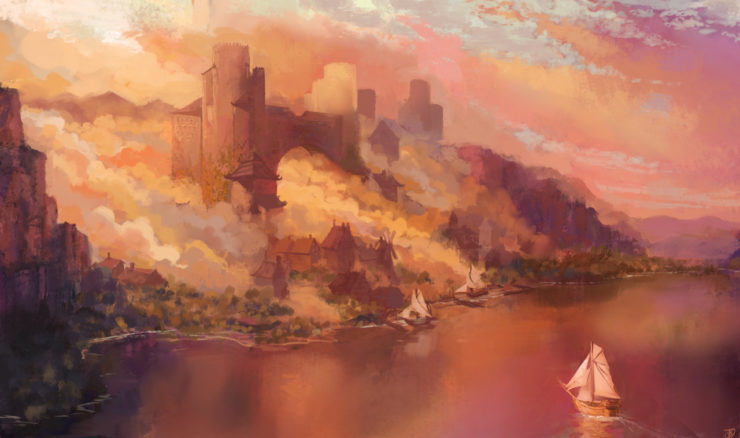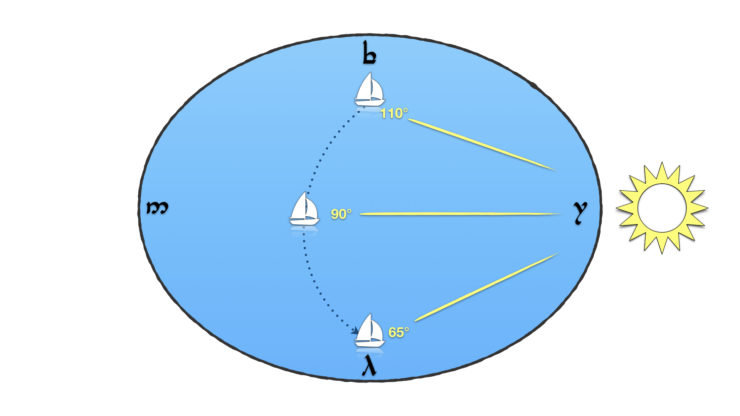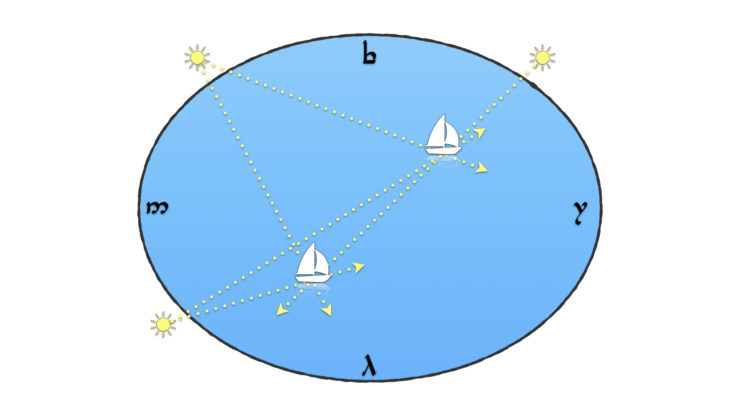How on earth did the Númenóreans become such good mariners?
“Above all arts,” says the Akallabêth, the Men of Númenor “nourished ship-building and sea-craft, and they became mariners whose like shall never be again since the world was diminished; and voyaging upon the wide seas was the chief feat and adventure of their hardy men in the gallant days of their youth.” With the exception of the Undying Lands, travel to which was banned, the Dúnedain traversed the Sundering Sea and beyond: “from the darkness of the North to the heats of the South, and beyond the South to the Nether Darkness; and they came even into the inner seas, and sailed about Middle-earth and glimpsed from their high prows the Gates of Morning in the East.” In other words: they got around.
To travel the world like that doesn’t just require hardy seafarers and ships, it requires skilled navigation. And that’s where the problem is. Before the Changing of the World that destroyed Númenor bent the seas and made the world round, the world—Arda—was flat. And if you know enough about maps, navigation, or mucking about with boats, you know that will have serious implications for navigation.
Think about how a sailing crew would navigate on our world. During the later years of the Age of Sail, a navigator might make use of a compass, a sextant and a marine chronometer to figure out their precise location on a map—the compass to determine bearing; the sextant to determine the latitude from the height of the Sun at noon or Polaris at night; the chronometer to determine longitude. (Longitude can be determined by measuring the difference in time between noon in two locations: if local noon is an hour earlier in one position than it is in another, it’s 15 degrees west of that other position.) Earlier in maritime history an astrolabe or a Jacob’s staff would have been used instead of a sextant.
All of these tools are predicated on a spherical (okay, oblate spheroid) world. On a flat earth they wouldn’t work the same way, or even at all. On a flat earth, noon takes place at the same time around the world—Arda has no time zones—so longitude can’t be determined that way. And while the angle of the Sun or the celestial north pole might change the further north or south you go, it would not (as we will see) be a reliable way of determining latitude.
So how could the Númenóreans have navigated? That’s a surprisingly tricky question—one I didn’t think would have a good answer when I started working on this article. But it turns out that there are methods they could have used to cross the wide seas of Arda without getting completely and hopelessly lost. In this thought experiment, I explore how they might have done it.
Sea-Craft in Middle-earth
But before we talk about navigating Tolkien’s seas, let’s establish what we know about them.
For all of the talk of Sea-Kings and of passing over the Sea, and for all the characters from Tuor to Legolas coming down with case after incurable case of thalassophilia, the Sea plays a relatively small role in Tolkien’s legendarium. In a 2010 essay for TheOneRing.net, Ringer Squire notes that Tolkien mostly keeps the Sea off-stage. “In the annals of Middle-earth there is no action at sea, no description of the moods of the ocean, no engagement with the voyages as voyages. Tolkien’s Sea for all its greatness is merely the context for a text about Lands.” It acts as both borderland and staging area: deeps for ships to come out of, like Elendil’s nine ships out of the wreck of Númenor, or to disappear into, like the ship bearing the Ring-bearers away at the end of The Return of the King.
As such, we have few details of the seafaring aspects of the cultures of Middle-earth, Númenor or Eldamar, because it’s not the central focus of the story. Even Eärendil’s pivotal voyage is dealt with in a single paragraph. Mostly we read about ships and shipbuilding: about Círdan the Shipwright, the swan-ships of Alqualondë, the vast fleets of the Númenóreans built to challenge the might of Mordor and (later) Valinor. The focus is on ships’ seaworthiness (Telerin ships are apparently unsinkable) rather than sailing prowess.
Artists working in the Tolkien legendarium generally depict small, open single-masted boats, with square or lateen sails. Most of them seem to have oars: Eärendil’s ship Vingilot had them, and in Unfinished Tales an approaching Eldarin ship was remarked upon for being oarless. The ships were not always small: Númenor in particular was capable of building gargantuan vessels. Aldarion’s ship Hirilondë is described in Unfinished Tales as “like a castle with tall masts and great sails like clouds, bearing men and stores enough for a town.” Millenia later, Ar-Pharazôn’s flagship Alcarondas, the Castle of the Sea, is described as “many-oared” and “many-masted,” and with “many strong slaves to row beneath the lash.” (Remember, kids: Ar-Pharazôn is bad.)
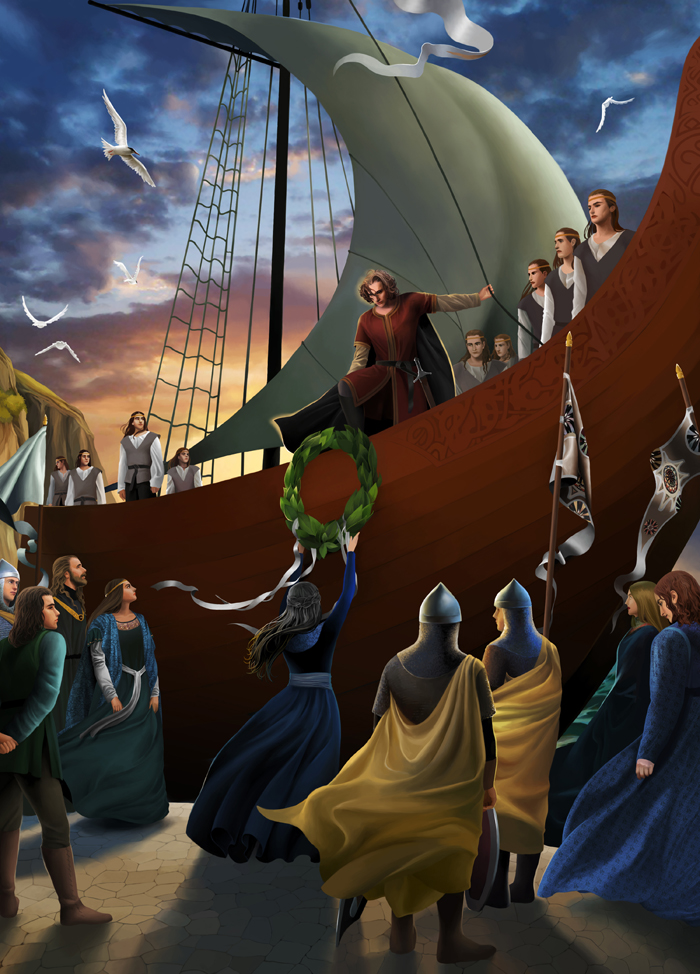
Either way, large or small, we’re talking about galleys rather than pure sailing vessels: boats that rely on muscle power when the winds fail or are unfavourable. Winds nevertheless play a major role in Númenórean seafaring: “Aldarion and Erendis,” a chapter in Unfinished Tales that includes more about Númenórean seafaring than any other source, describes riding the spring winds blowing from the west, ships “borne by the winds with foam at its throat to coasts and havens unguessed,” and being beset by “contrary winds and great storms.”
In dealing with those winds and storms there is a certain amount of divine intervention, or at least divine restraint, on the part of Ossë and Uinen, the Maiar responsible for storms and calm waters, respectively. As Aldarion’s father, Tar-Meneldur the fifth king of Númenor, remonstrates with him,
Do you forget that the Edain dwell here under the grace of the Lords of the West, that Uinen is kind to us, and Ossë is restrained? Our ships are guarded, and other hands guide them than ours. So be not overproud, or the grace may wane; and do not presume that it will extend to those who risk themselves without need upon the rocks of strange shores or in the lands of men of darkness.
Emphasis added in bold: the Dúnedain are not necessarily masters of their own craft.
How Could They Have Navigated?
Following the winds and the weather (and when they’re adverse, enduring them), is a rather passive form of sea-craft, and strange spirits lying in seas is no basis for a system of navigation. Surely the Dúnedain had more agency than that when it came to feats and adventure.
Fortunately, there are methods of finding your way at sea that could be used on a flat world. John Edward Huth sets out a number of them in his 2013 book, The Lost Art of Finding Your Way, which discusses the strategies by which pre-GPS human beings used to be able to avoid getting lost. Huth’s book is an argument for mindfulness and situational awareness: awareness of your surroundings, of the factors that may push you off course, and the tricks you can use to put you right again. For sea-based navigation, they include:
- Using wind direction as a natural compass;
- Following the migration paths of birds;
- Local knowledge of currents and tides;
- Local knowledge of the interference patterns in the waves created by nearby land; and
- Dead reckoning: using distance and direction travelled to estimate your current position.
Currents and winds and tides, a connection to the sea: these methods have a certain poetry, a certain lack of technology, a certain naturalness that would no doubt appeal to Tolkien’s anti-modern outlook, and were probably what he would have had in mind if he had given some thought to this subject. One imagines what Strider the Ranger would do at sea.
But are they enough?
It depends on where you’re sailing, and how far; but as far as the Númenóreans are concerned, no, they aren’t.
Each of these methods has a margin of error that gets larger the further you travel. The winds can change. Currents induce drift. Dead reckoning’s uncertainties—figured by Huth as between five and ten percent—accumulate over time, like an expanding cone. The further you go, the less accurate your path, the further off course you can get without knowing it. You need to get a fix on your actual position on a regular basis.
This is not a problem when navigating short or even medium distances. Significant error will not have time to accumulate: if you’re off by only a few miles, you can correct your course visually. And if your journey has many intermediate steps—if, for example, you’re hopping from island to island—you can get a fix on your position at every stop, increasing the accuracy of your overall route.
The Númenóreans, however, were sailing over large distances. How large? The maps in Karen Wynne Fonstad’s Atlas of Middle-earth come with a scale, so we can figure that out.
| To | Approximate Distance | Heading | Travel Time |
|---|---|---|---|
| Mithlond (Grey Havens) | 1,900 miles | NNE | 24 days |
| Vinyalondë (Lond Daer) | 1,700 miles | NE | 22 days |
| Pelargir | 1,800 miles | ENE | 23 days |
| Umbar | 1,600 miles | ENE | 20 days |
The ports in Middle-earth used by the Dúnedain were between 1,600 and 1,900 miles from the main Númenórean haven of Rómenna, on a roughly north-easterly heading. Ships in the early Age of Sail could average about eighty miles a day; using that as our benchmark, and assuming ideal conditions, it should take between three and four weeks to make the journey from Númenor to Middle-earth. Ideal conditions—and an improbably straight line. More realistically, a month would be considered exceptionally quick.
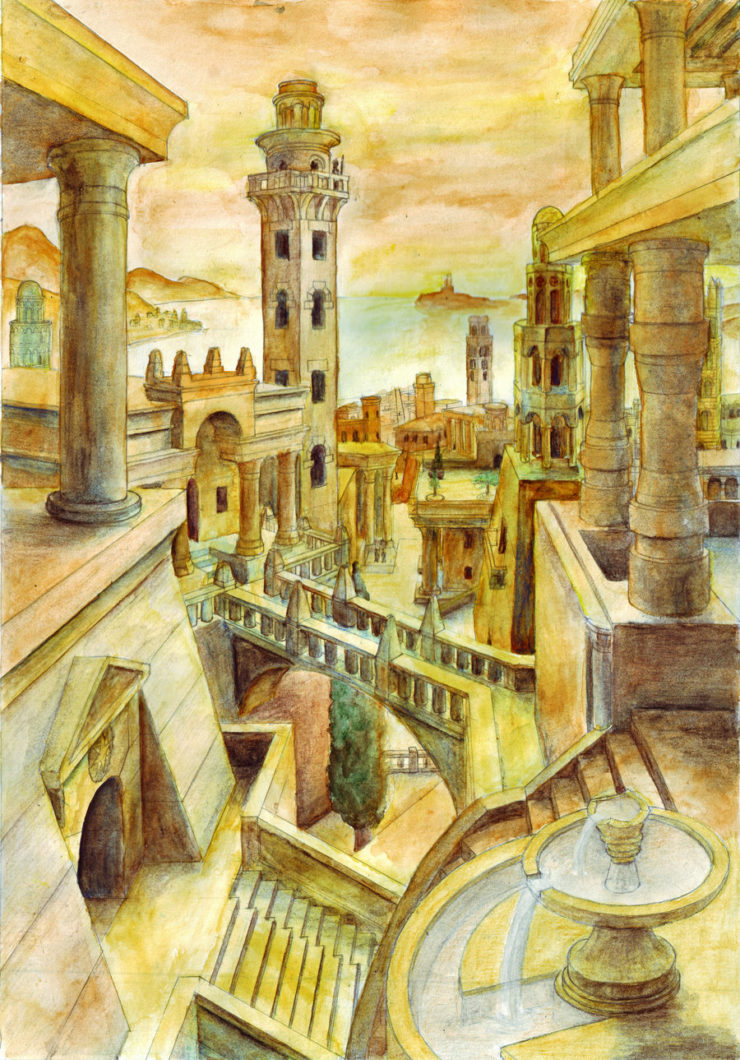
But the problem isn’t that it’s 1,600 to 1,900 miles. It’s 1,600 to 1,900 miles over uninterrupted ocean. The distance between Númenor and Middle-earth is roughly the same as the distance between Norway and Greenland, but the Norse never did that trip in one go: they could, for example, stop at Shetland, the Faroe Islands, and Iceland. There appear to be no islands between Númenor and Middle-earth, which means there are no intermediate stops for Númenórean ships to pause and reorient themselves. Nowhere on land to get a fix. The chances of drifting off course are quite high.
This isn’t much of an issue when sailing from Númenor to Middle-earth: Middle-earth is huge and hard to miss. If you were aiming for Mithlond and end up at Umbar instead, you can work your way up the coast and still make your date with Gil-galad. Getting back home is a little trickier: at 250 miles across, Númenor is a smaller target, though not particularly small. Assuming Huth’s five to ten percent uncertainty, the cone of uncertainty would be around 160 to 380 miles. It would be difficult for a seasoned mariner to miss that target, especially given the extended horizon of a flat world and the good eyesight of the Dúnedain. Plus there’s the Meneltarma: the mother of all trig pillars.
But wait! Huth’s five to ten percent uncertainty assumes the use of a compass. Do the Númenóreans even have compasses? We don’t know whether Arda has a magnetic field: it hasn’t come up in Tolkien’s writings, as far as I’m aware. Earth’s magnetic field is the result of its outer core acting as a dynamo: it requires planetary rotation. Because Arda is not round and does not spin, it won’t have a magnetic field—not unless one of Aulë’s Maiar is tasked with churning things up in the deeps. So compasses may not be a thing, in which case sailing past Númenor—and into trouble—just got a lot more likely.
So, our Númenórean navigators need to solve two problems: how to figure out a ship’s bearing, and how to get a fix at sea.
Bearing and Position
If magnetic compasses aren’t an option, the Númenórean navigators would have to resort to celestial methods to determine bearing. For example, the Sun. Even on Arda, the Sun rises in the East and sets in the West, and so sunrise and sunset can be used to determine a rough heading. But on Arda, because the Sun rises and sets at exactly the same point, the azimuth angle of the sunrise changes depending on your position, not just your latitude. A ship keeping the rising Sun to port would sail in a long arc curving from southwest to southeast, and the effect would be greater the further east it was. You could compensate for it, but first you’d need to know your exact position, and solving the problem would be more complicated over long voyages.
Something similar would occur if the navigators used the stars as their guide. We know that Tolkien’s celestial sphere rotates on its axis, because we’re told that Tar-Meneldur observed the motions of the stars from a tower in the north of Númenor. Enter star compasses. Based on the position of rising and setting stars, star compasses have been used both by Arab navigators in the Indian Ocean and by Pacific Islanders: at equatorial latitudes a star will rise at the same point, giving a consistent bearing. On a flat earth like Arda it should operate at any latitude, and the same equatorial stars and constellations would be useable, but there’s a catch: like the rising Sun, the azimuth of a rising star would change depend on your position. Borgil (Aldebaran) and Helluin (Sirius) would rise at a different angle relative to true north in Lindon than it would in Umbar, just as the Sun does.
Which means that the Númenórean navigators can’t determine an accurate bearing without knowing their position. So how do they determine their position? As I mentioned above, longitude can’t be determined by the Sun at high noon. Nor can latitude: the Sun would appear to have the same apparent altitude in a circle around the centre of the world, rather than along parallels of latitude.
Since we’ve been talking about azimuth, a solution presents itself: triangulation.
You can’t do very much with the azimuth of the rising point of a single star. With a second star, or even the Sun, the observer is now at the intersection of two lines between themselves and the two stars—position lines. That gives the angle between the two stars. If the observer also knows the direction of true north (or west, or east), that would be sufficient to determine position, but on Arda, as we’ve established, we need to find position before we can find bearing. So we add a third star and a third position line. The angles between these three lines will be unique for every position on the earth.
This is similar to the intercept method still used in navigation today (as well as the method my computerized telescope uses to align itself). The intercept method combines position lines derived from celestial observations with more conventional means of navigation (the chronometer, the sextant, charts and tables) to achieve a high degree of accuracy. Since many of those conventional methods wouldn’t work on a flat earth, the Númenóreans wouldn’t be able to be quite that accurate. But it would be far more accurate than dead reckoning, and—more importantly—it would allow them to get a fix at sea.
I imagine it working something like this: In the same way that Ptolemy’s Geography or medieval astronomical tables collected longitude/latitude coordinates for cities in the known world, the Númenóreans would collect angles. Getting a fix at sea would involve taking new angular measurements and comparing them to what was already recorded. Perhaps there would be a set of tables carried by every ship’s master, or perhaps there would be a lot of math involved; either way, the new position could be interpolated into what was already known. But however it was done, it could be done. If nothing else, they’d have nearly three thousand years to get good at it.
This method yields two unusual outcomes. One is that because they’re measuring azimuth rather than altitude, Númenórean navigation instruments would be held horizontally; sextants, octants, and astrolabes are held vertically. And, as I suggested above, bearing would be derived from position. Once a navigator determines their ship’s position, they will know the angular difference between the position lines and the compass points: for example, that north is 80 degrees clockwise of the rising of Borgil at this location. It would be a good deal more complicated than using a magnetic compass, but more consistent, because magnetic declination wouldn’t be a factor.
But a significant drawback is that bearing could not be checked throughout the day: following a compass heading or a rhumb line wouldn’t be possible. You sail; at night you get a fix and see how far off course you’ve gone over the course of the day; you make corrections for the next day’s sailing. Which means that a Númenórean navigator requires clear, starry skies—if you’re beset by storms or clouds, your ability to navigate drops precipitously. In a cosmology where angelic spirits rule the winds and the waves and the skies, it really would behoove you to remain in their good graces.
The Changing of the World
Of course, everything changed with the Downfall. The mariners of the Dúnedain kingdoms in exile, Gondor and Arnor, would be starting from scratch. Ossë and Uinen would no longer be factors, and the stars would, from their perspective, behave strangely: they would be different if they moved too far south, and their angles would not change if they moved east to west. They would have to learn navigation all over again, on seas that operated under entirely new rules.
Small wonder the Exiles, who managed to, you know, circumnavigate the globe, nevertheless saw their Númenórean forebears as “mariners whose like shall never be again since the world was diminished”: they mastered lost seas in ways that were now forever obsolete.
This month, we’re celebrating the legacy of J.R.R. Tolkien with a look back at some of our favorite articles and essays about Middle-earth. A version of this article was originally published in November 2018.
Jonathan Crowe blogs about maps at The Map Room and reviews Canadian science fiction for AE. His sf fanzine, Ecdysis, was a two-time Aurora Award finalist. He lives in Shawville, Quebec, with his wife, their three cats, and an uncomfortable number of snakes. He’s on Twitter at @mcwetboy.










